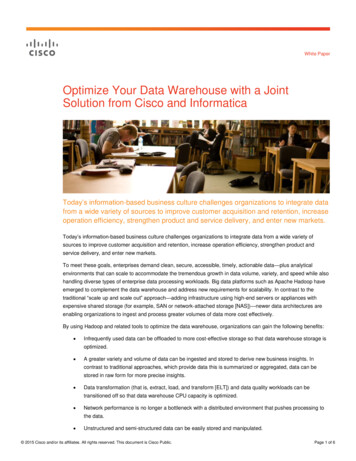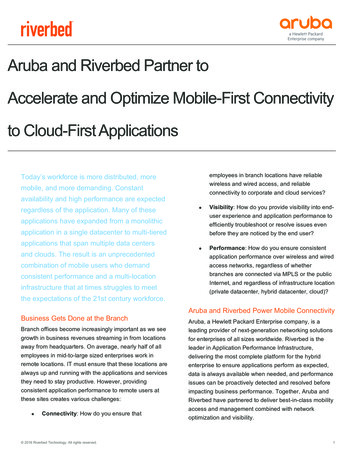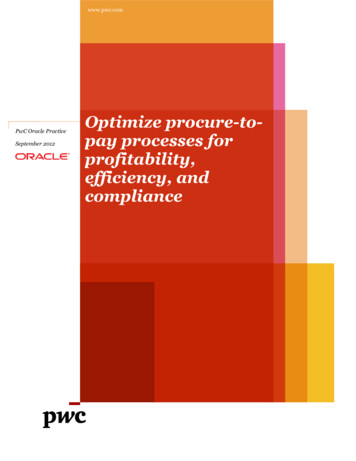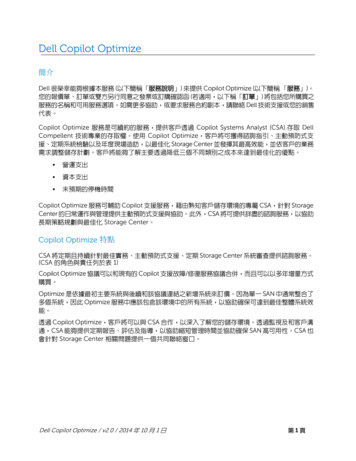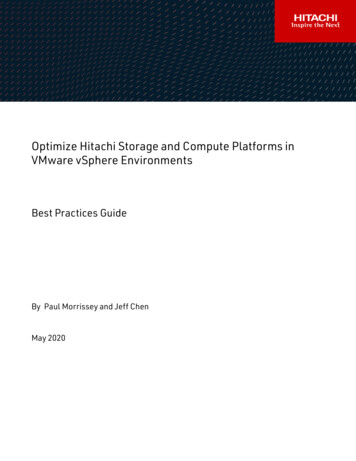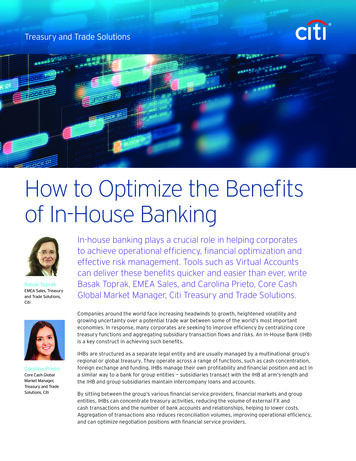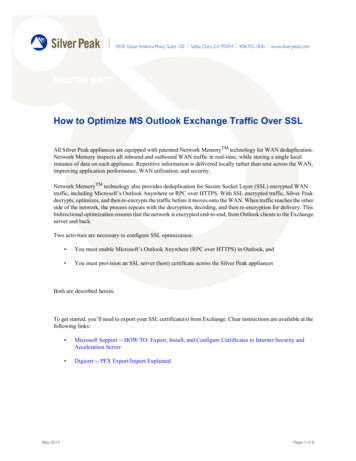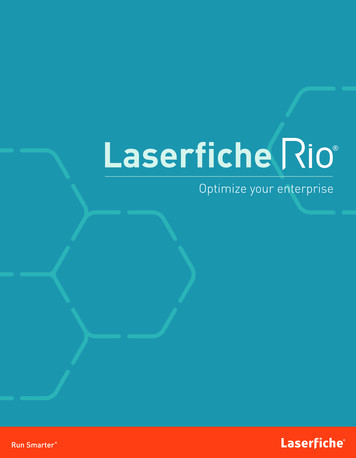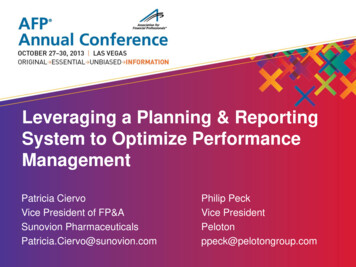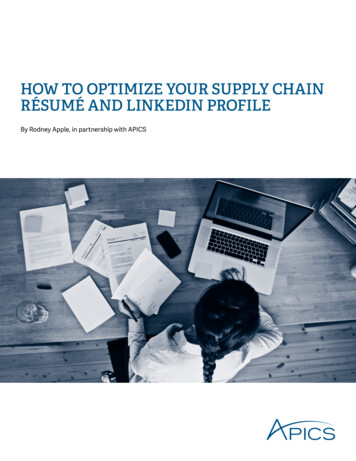
Transcription
HOW TO OPTIMIZE YOUR SUPPLY CHAINRÉSUMÉ AND LINKEDIN PROFILEBy Rodney Apple, in partnership with APICS
INTRODUCTIONLove them or hate them (most people fall into the latter category), résumés are by far themost important and most commonly used career marketing tool within the business world.The primary goal of a résumé is to land a job interview. In order to achieve this goal, youmust produce a résumé that “wows” your target audience—employers and recruiters.If your résumé is boring, difficult to quickly scan, too long, too short, poorly formatted, displaysfew or no accomplishments, or contains spelling or grammar mistakes, you are not goingto wow your target audience and land good job interviews. But if your résumé is neatlyorganized and formatted with easy-to-scan content that quickly highlights your professionalsummary, work history, major accomplishments and education, it can wow your audienceand, in turn, lead to more job interviews.The second most important career marketing tool, which resides on the Internet instead ofa computer, is your LinkedIn profile. LinkedIn quickly became the number one professionalnetworking website on the Internet not long after launching in 2003. Today, LinkedIn hasgrown to well over 300 million members globally.If you are not on LinkedIn at all, or if you have not yet completed and optimized your profile,you are most likely missing out on career and business-oriented opportunities. LinkedIn isdesigned to connect business professionals and has become the go-to networking site forbusiness professionals and employers—and especially for recruiters.This white paper explains the core elements of a strong supply chain résumé and LinkedInprofile, and provides plenty of tips and best practices for you to implement so you candevelop a winning supply chain résumé and fully optimize your LinkedIn profile.2HOWTHEYOURART OFJOB INTERVIEWINGHOW TOTOMASTEROPTIMIZESUPPLYCHAIN RÉSUMÉ AND LINKEDIN PROFILE
HOW TO OPTIMIZE YOUR SUPPLY CHAINRÉSUMÉ AND LINKEDIN PROFILEBY RODNEY APPLE, IN PARTNERSHIP WITH APICSTABLE OF CONTENTSCore Elements of a Strong Supply Chain Résumé4Résumé Formatting Tips and Best Practices10Tips for Optimizing Your LinkedIn Profile and Network16Summary: Using your Résumé as a Marketing Tool24HOW TO OPTIMIZE YOUR SUPPLY CHAIN RÉSUMÉ AND LINKEDIN PROFILE3
CORE ELEMENTS OF ASTRONG SUPPLY CHAIN RÉSUMÉ4HOW TO OPTIMIZE YOUR SUPPLY CHAIN RÉSUMÉ AND LINKEDIN PROFILE
You should think of your résumé as your primary marketing tool—a tool designed to “highlight” yourunique blend of work experience, education, training and accomplishments. In order to produce anattention-grabbing marketing tool that generates positive responses from your target audience, it’svery important to understand the core elements of a strong supply chain résumé as well as résumébest practices.RÉSUMÉ ORGANIZATIONAL FORMATSThere are three basic résumé organizational formats of which you need to be aware:Chronological Résumé Format: This format is by far the most popular and the most preferred byrecruiters and employers. Additionally, it is typically the only format that job boards and employerapplicant tracking systems will accept. With chronological résumés, your work experience is listed inreverse chronological order (that is, from your current or most recent job to your least recent). Thisformat is preferred because employers and recruiters want to be able to quickly understand whattypes of employers and industries you’ve worked in, your core job responsibilities and, mostimportant, your accomplishments.Functional Résumé Format: This format is the least popular and least preferred by recruiters andemployers. Instead of listing your work experience by job in reverse chronological order, youorganize your résumé by job functions/skills without listing employer information such as companynames and employment dates. Job boards and employer applicant tracking systems typically willnot accept a résumé in this format.Hybrid Chrono-functional Format: This format is basically a combination of the chronological andfunctional résumé formats. While it’s an improvement upon the functional résumé format, it’s stillnot preferred over the chronological format. Job boards and employer applicant tracking systemstypically will not accept a résumé in this format either.WHEN TO USE FUNCTIONAL OR CHRONO-FUNCTIONAL RÉSUMÉ FORMATSAgain, I do not recommend using these two formats for the reasons stated above, but here are a fewsituations that could warrant a chrono-functional or functional résumé format:1. Long-term unemployment, frequent job moves and/or major gaps in employment2. Making an effort to change careers/industries by showcasing transferable skill sets3. To provide a supplement to your chronological résuméHOW TO OPTIMIZE YOUR SUPPLY CHAIN RÉSUMÉ AND LINKEDIN PROFILE5
PRIMARY RÉSUMÉ SECTIONS AND ATTRIBUTESContact Information While this is an obvious key résumé element, I have reviewed countless résumésfrom candidates that get this one easy step wrong.Minimum contact infoFull Name. List your first and last name (not your first initial, then last name or first name, then last initial).Professional Credentials. List these (e.g., CPIM, CSCP, CPM, PhD) right behind your name if applicableto supply chain and/or the job for which you plan to apply.Home Address. If you don’t feel comfortable specifying your street address because of securityconcerns, at least put in your city, state and zip code. Why? When you apply online through acompany’s career site or upload your résumé to a job board, applicant tracking system softwareautomatically parses you, starting with your contact information. If you don’t at least include yourcity, state and zip code, the system has no way of knowing what city and state you reside in. This canbe problematic because recruiters commonly run candidate searches through the same applicanttracking system, often searching for local candidates by city, state or distance/radius to a zip code.Not including this information means it’s likely you will not show up in a recruiter’s search results.Personal Email Address. Include your permanent personal email address—never a work email address.If you use a work address, you run the risk of your employer finding out that you’re in job search mode,which can lead to termination or at the least an awkward moment with your boss or HR. In addition, ifyou send out your résumé with that work address and then leave that employer, anyone who later triesto contact you about a job will get no response other than an automated bounce-back stating therecipient (you) doesn’t exist.You should also make sure you’re using a professional-sounding email address. I’ve come across someextremely cheesy or even rude email addresses in the past, and these can be a turnoff to employers—for example, something like ilovebourbon@hotmail.com. Play it smart.Personal Phone Number. I recommend that you use your personal mobile number—never your worknumber—for the same reasons you shouldn’t use a work email address. If you prefer to use yourhome number, that’s fine, but I recommend that you double-check your home answering machinegreeting to make sure it’s professional-sounding. Another option is to set up a free Google Voicenumber you can set up to email you a transcript of every voice mail, screen every call, and forwardcalls to another number. There is no need to list a fax number.6HOW TO OPTIMIZE YOUR SUPPLY CHAIN RÉSUMÉ AND LINKEDIN PROFILE
Optional contact infoWebsite or Blog URL. If you maintain a professional website and/or blog, you should include the link soemployers can easily make one click to learn more about your background and experience.LinkedIn Profile URL. Most recruiters and employers will check out LinkedIn profiles for candidatesthey’re interested in soon after reviewing their résumés. You might as well make it easy for them to findyou on LinkedIn by including the link. However, if you haven’t taken the time to complete your LinkedInprofile in full yet, don’t include the link.Professional Headline (replaces “Objective Statement”)Instead of using the outdated “objective statement,” which is typically centered on the type of job/company/industry a candidate wishes to pursue, try using a professional headline instead. This is acatchy one-line statement that quickly highlights the core of what you do or your unique valueproposition from a work perspective. You can view this as a sales pitch or branding statement if youlike. Here are a couple of examples:“Wide range of strategic supply chain leadership experience with a focus on enabling andsustaining revenue growth by streamlining operations, improving customer service levels andreducing operating costs”“Warehousing leadership professional with a long history of transforming underperformingdistribution facilities into best-in-class fulfillment centers”Professional SummaryIn this section, provide a keyword-rich summary of your skills and qualifications in bullet format(not long, difficult-to-scan blocks of paragraphs). This section can include some or all of the following:nFunctional keywords such as logistics, sourcing, procurement, warehousing or S&OPnTechnical keywords such as Warehouse Management Systems, SAP or OraclenSoft skills like change agent, high-performing work teams or transformational leaderThis section serves two purposes:nnIt gives the reader a quick overview of your core skill set and the value you can bring to the tableIt contains the primary keywords that recruiters and employers typically use in a résumé databasesearch to find candidates just like youIf you don’t want to use “Professional Summary” as the headline for this particular section, there areplenty of other suitable options such as “Executive Summary,” “Summary of Qualifications,”“Professional Profile” or “Background Summary.”HOW TO OPTIMIZE YOUR SUPPLY CHAIN RÉSUMÉ AND LINKEDIN PROFILE7
Employment History and AccomplishmentsThis is the most important and most read section of your résumé. It’s what I call “the meat” of a résumé,so it’s critical that you nail this section when writing it.When I review a résumé, I quickly scan from the very top through the professional summary, oftenwithin a few seconds, until I land on this section. Once I get to this section I quickly scan througheach job the candidate has held—mainly to determine whether or not the person is a fit for theposition I’m trying to fill.The most important aspect of this particular section is ACCOMPLISHMENTS. Recruiters andemployers want to understand the value you delivered in each job for each employer. If you list onlyyour job duties and responsibilities, and leave out your accomplishments, we recruiters have noearthly idea what kind of value you delivered for your current and past employers. When there’s noperceived value, we typically move on to the next résumé.I cannot stress how important it is to detail accomplishments in your résumé. In addition to listingyour accomplishments, always strive to quantify the results of your accomplishments wheneverpossible using details such as numbers, percentages, dollar savings and budget figures. Listingsignificant and relevant accomplishments along with quantifying results for each accomplishmentcan lead to “wowing” your target audience, resulting in more job interviews.Information to include in this section:nEmployer name with a very brief employer bio (one-line bio if possible)nJob location (city and state)nEmployment dates (month/year format)nAccomplishment-focused action statements in bullet format that describe the value you delivered,ideally with quantified resultsAdditional information you may want to include:nnn8Provide brief reasons for any long-term employment gaps and short-term job stintsIf your company was acquired, especially if it changed names more than once, you may want toprovide an explanation within the employer bio(s)Size and scope information (e.g., size of warehouse you managed, number of employees managedin a plant, industry-specific information and other relevant job-related context)HOW TO OPTIMIZE YOUR SUPPLY CHAIN RÉSUMÉ AND LINKEDIN PROFILE
Education, Training, Associations, CertificatesInclude all pertinent educational information in this section. Be sure to spell out the name of thecollege or university you attended, the type of degree(s) obtained, and the location (city/state) of theinstitution. Your graduation date is optional, but I recommend including it if you have graduatedwithin the last decade.If you have a favorable GPA and have recently graduated, I recommend listing it. It isn’t as importantto include your GPA once you have a few years of work experience under your belt. If you are currentlyattending school, be sure to detail this along with your estimated graduation date. If you didn’tcomplete a degree, you may want to include the amount of education you did obtain—“three years”or “X amount of credits,” for example.If you have received any special training or certificates or belong to any professional associations, youshould list the details after your degree information.Recent or soon-to-be college grads should list your education and training at the very top of yourrésumé, followed by pertinent experience you’ve received. This could include internships, volunteerpositions, co-ops, class projects, sports teams, studies abroad or fraternity/sorority leadership roles.Once you obtain a few years of relevant work experience, you can move your education section to theend of your résumé.Miscellaneous/Optional Résumé InformationFeel free to include the following information at the very end of your résumé if you feel it’s importantand would add weight to your résumé:nMemberships and other associations (e.g., Toastmasters Club)nRelevant publications, articles and presentationsnAdditional languages (those you read, speak and write)nSpecial security clearancesnVolunteer and community servicenMilitary exper
n Technical keywords such as Warehouse Management Systems, SAP or Oracle n Soft skills like change agent, high-performing work teams or transformational leader This section serves two purposes: n It gives the reader a quick overview of your core skill set and the value you can bring to the table
